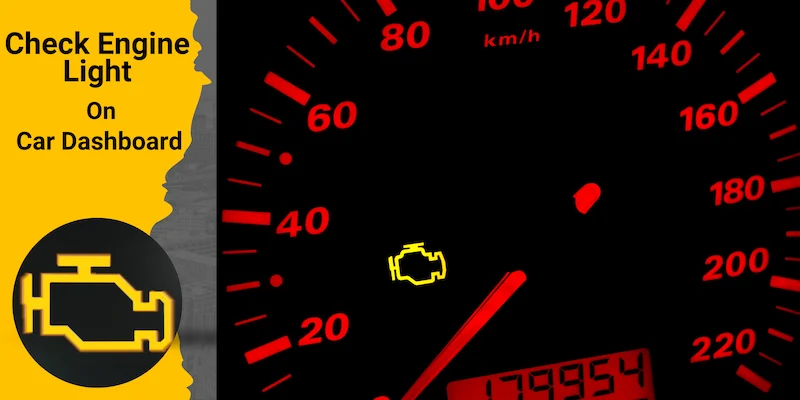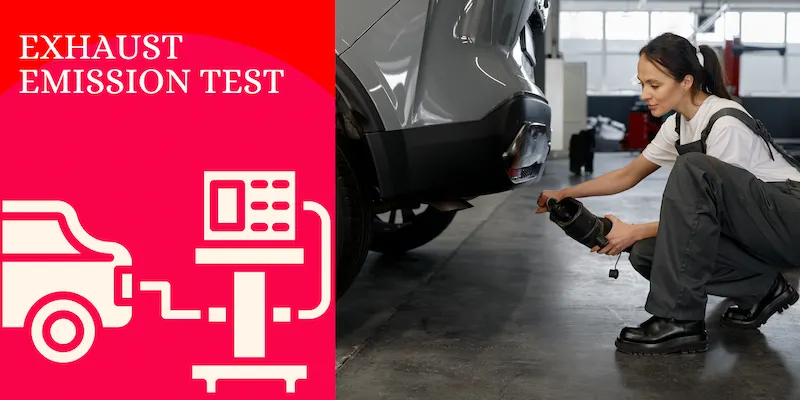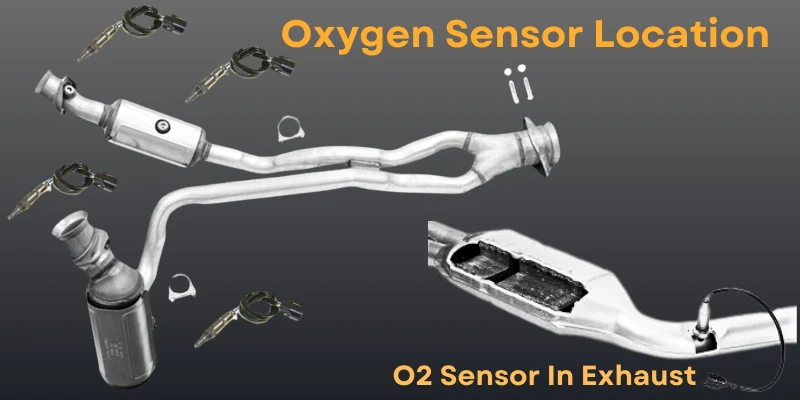Signs of a Bad or Failing Oxygen Sensor and Its Effect on Performance
Updated: 18 May 2024
83
Before taking around the impact of a faulty oxygen sensor, it’s essential to understand the role (function) in the vehicle’s operation. The oxygen sensor is located in the exhaust system and monitors the oxygen level in exhaust gases. This data calculated in ECU adjusts the air-fuel ratio suitable for combustion to achieve optimal engine performance with good fuel efficiency.
In this guide, we also discuss the common symptoms of a bad O2 sensor, how much you can spend to replace it, and when to repair it to get maximum performance.
Oxygen Sensor Function

Because of the combustion process in a car engine, exhaust gases are produced due to fuel-air ignited in the cylinders. These exhaust gases contain oxygen and carbon, along with several gases. The oxygen sensors monitor the level of the gases leaving the car engine. This sensor measures the oxygen flowing through the combustion process.
This information is received through the oxygen sensor sent to the Engine Control Module (ECM); this computer is responsible for the whole process, and as per particular information, the air-fuel ratio needs to be adjusted; if the ECM reads there’s more oxygen, it will adjust other sensors to release more fuel. Otherwise, the combustion cycle continues in either lean or rich conditions, increasing fuel economy and leading to engine troubles and damage to other components.
The catalytic converter needs additional wear. Continue imbalanced exhaust gas flow, which may also cause damage to this expensive part. It’s advised that the repair be done as soon as possible.
Diagnosing a Faulty Oxygen Sensor
In modern vehicles, an OBD-II scanner is a way to investigate issues by retrieving error codes stored in the car ECU after connecting OBD-II devices(scanner) in the vehicle’s assigned port.
Visual inspection of the sensor and voltage testing were helpful in finding out whether the sensor was faulty or worked properly to avoid unnecessary expenses.
Signs (Symptoms) of a Bad Oxygen Sensor
It’s important to Identify whether the oxygen sensor is working properly because it affects vehicle performance; here are some signs which were noticed throughout practical experience, it advised if any of the following sign was declared during observation, it’s essential to address the issue as soon to damage engine and exhaust system.
1). Check the Engine Light in Vehicle Dashboard

The most common symptom of a bad oxygen sensor is a check engine light on your dashboard, further analyzing through the trouble code shown in the OBD scanner.
Trouble codes related to bad oxygen sensors (P0030, P0031, P0130, P0131, P0132, P0133, P0134, also P0137, P0140, P0141, P0161, P172). Some trouble codes were related to the air-fuel mixture, ultimately caused by the oxygen sensors.
2). Decreased Fuel Economy

The combustion chamber has a balanced amount of air-fuel mixture; if the Oxygen sensor malfunctions, it will not detect more fuel than air. As a result, unnecessary fuel combusts in the engine will decrease fuel mileage, and frequent gas station trips will cost money.
3). Rough Idle (High RPM in Idle)
If your car stops at a signal or in parking, Usually the RPM gauge at idle should be between 1,000; if it shoots up, this is also one of the signs of a bad O2 sensor; however, it is not in most cases, but it probably the other component defective that balancing Air fuel ratio.
4). Stalling Engine( Shutdown Engine in Idle)
When the engine idle gets rough, the vehicle could stall (engine shutdown itself), and this problem starts as a misfire; this issue occurs because the problem remains unsolved, which could be dangerous while driving on the road.
5). Poor Vehicle Performance

When the engine combustion process is disturbed, you can notice the engine’s worse performance, especially after pushing the gas pedal. This problem will continue getting worse when driving on full load. That’s why it’s advised to look up the fault as soon as you notice; this lack of acceleration will cause a road accident. A decrease in engine performance is a strong indicator of bad O2 sensors.
6). Strange Sounds
If the oxygen sensor is faulty, the air-fuel mixture is not maintained correctly, and the abundant carbon build-up in the combustion chamber will cause a lean running mixture in the engine. The lean mixture left pre-ignition caused a knocking sound. Other causes of the pinging noise are clogged fuel injectors, fuel quality, and damaged engines. Mostly, these noises are heard under engine load.
7). Catalytic Converter Failure
The catalytic converter will eventually fail if you run with a bad oxygen sensor due to an air-fuel imbalance. The oxygen sensor works additionally to prevent catalytic converter. You can spend more replacing the catalytic converter; changing the damaged oxygen sensor is worth avoiding further problems.
8). Failed Emission Test

The malfunction of oxygen sensors causes an imbalance in the vehicle’s emission control system, usually detected in exhaust emission tests. The oxygen sensor is a major culprit, but there were a lot of other reasons to fail these mandatory tests. Computer inspection will check the type of codes that indicate the exact fault.
Oxygen Sensor Location

The oxygen sensor is available in the exhaust system, near the engine or on the exhaust manifold. Most cars have several Oxygen(O2) sensors, all of which monitor the amount of oxygen in the exhaust pipe.
If the car has more than one sensor, the other will be located after the catalytic converter. These were used to monitor the converter’s performance by comparing the readings occurring before and after converting.
Oxygen Sensor Replacement Cost
Considering the average expenses to replace a bad oxygen sensor, you may spend $60 to $500. However, it depends on several factors; your costs are lower if you drive a low-budget car. If it is a high-budget, just like a luxurious car, SUV, or truck, their parts are expensive, and they also need a specialized mechanic to work, and labour charges need to be added, which increases the overall total.
If you can replace the oxygen sensor by yourself without professional help, it will cost $40 to $200, with only parts to be purchased.
Delaying the change of the oxygen sensor can damage other parts, which increases further expenses. Considering the replacement of the oxygen sensor and swapping the catalytic convertor as new, on average, $1200 to $2400.
FAQ’s
Is it Safe to Drive with a Bad Oxygen Sensor?
Technically, it’s possible to drive along a faulty O2 sensor, but it is not recommended as it leads to decreased fuel efficiency and engine performance.
Can a Bad Oxygen Sensor Cause Engine Damage?
A lousy oxygen sensor itself does not damage the engine directly. Still, prolonged operation with a malfunctioned sensor leads to issues of poor fuel combustion, which may eventually impact some engine components.
How long Does an Oxygen Sensor Last?
The oxygen sensor’s lifespan depends on factors such as driving conditions and vehicle maintenance, but typically between 50,000 and 100,000 miles.
Can Cleaning the Oxygen Sensor Fix It?
In some cases, cleaning the oxygen sensor may temporarily improve its performance, but replacement is usually necessary for long-term reliability if the sensor is damaged or worn out.
Can I Replace the Oxygen Sensor by Myself?
Yes, you can replace an oxygen sensor by yourself; in some cases, when the car is too old, or the oxygen sensor is stuck due to extreme rust, you can use special tools and apply anti-rust chemicals(WD-40) to leave it for a while. It will likely be open to replacement as new without any damage.
Will the Check Engine Light Reset (Disappear) by Replacing the O2 Sensor?
Depends on the models; in some models, it will reset after replacing the O2 sensor. The remaining car models will be reset by connecting a scanner; the professional way to diagnose it is through the OBD-II scanner, where a mechanic can notice the problem, repair it, and reset it to default.
Can a Bad Oxygen Sensor Cause a Car to Fail Emissions Testing?
Yes, a malfunctioning oxygen sensor can increase emissions, potentially causing a vehicle to fail emissions testing.
Conclusion
A bad oxygen sensor has significant implications for vehicle performance. Leads to decreased fuel efficiency, engine misfires and increased emissions. Recognizing the signs of a faulty sensor, diagnosing the issue accurately, and promptly addressing it through replacement or repair are essential steps in maintaining optimal engine operation. Drivers can ensure reliable performance and minimize costly repairs in the long run by prioritizing preventative maintenance and using high-quality replacement parts.
Please Write Your Comments